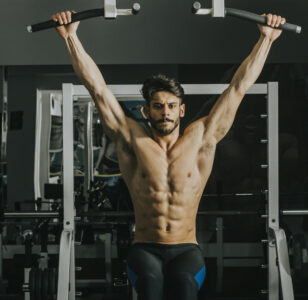Pull-ups are a great movement to train the back. The movement is mainly based on “pull”, which can well stimulate the arm muscle groups. In self-weight training, pull-ups are also not negligible fitness movements. You can use the Relife pull up bar to enhance your self-weight training, but you need to be strong enough to be able to complete the pull-ups. Because pull-ups are not just a good exercise, they are a good indicator of upper body strength. If you can’t do many chin–ups, your push-ups and bench press will improve as you get stronger with this important exercise. This is why pull-ups are the only extra exercise that can be added to a training plan for a beginner. pull-ups are divided into pull-ups and chin-ups, so are pull-ups or chin-ups better?

Pull-Up vs. Chin Up
The pull-up works the biceps the most and the brachioradialis the least. It is meant to make the upper back wider. The elbows should be over the back and the chest should be close to the bar.
The chin up is the weakest stimulus for the biceps and the strongest stimulus for the brachioradialis. It also pulls the latissimus dorsi longer, so you can use more weight and train the lower back very well.
Chin-ups and pull-ups are best for the latissimus dorsi, but they are also good for the rhomboids, serratus anterior, rotator cuff, and forearm and hand muscles. Even the chest muscles can be built up with chin-ups. This exercise can also work the abs if the trainer starts out hard from a hanging position and does enough reps to tire out the abs. If you have a good pull up dip bar in the process of home fitness, you can get a better fitness experience.
The main difference between the two is that the biceps are involved in the chin up, but the biceps do not play a role in the pull-up, where the biceps make the chin up easier than the forehand pull-up, while also satisfying the arm toning requirements. The chin up is more difficult, and it may place more emphasis on the degree of involvement of the latissimus dorsi, which is due to the absence of the biceps, so it must be done by other muscles that should have been done by it.
The reason the workout feels easier with Chin Up is that
At chin up, the grip distance is generally the same as or less than shoulder width. With this grip, the body is pulled up with the hands right in front of the body and the wrists are not uncomfortable due to the change in body rise and fall. When pull up is used, the grip distance is at least slightly wider than shoulder width. When the body is pulled up, the hands are at the sides of the body. Such a hand position is not so uncomfortable for the wrists, but the higher the body is pulled up, the more restricted the wrist angle becomes unless you use a palm-to-palm grip.
In short, chin up is easier than pull up because the small arms and wrists are in a more flexible and smoother direction of the force.

Pull Ups vs Chin Ups Which One Is Better For You?
If you want to practice pull-ups, chin ups and Pull Up both have to be done and neither should be abandoned. Here are a few suggestions that you can refer to and use in your training.
(1) The biggest benefit of Pull Up is that they can efficiently train the back muscle groups, mainly the latissimus dorsi. As a result, the more developed the biceps are, the more pull-ups should be practiced to better train the back.
(2) Grip distance matters more than chin up and pull up.
Wide grip Pull Up is good for developing the width of the upper latissimus dorsi. The wider the grip, the more difficult it is.
A narrow grip pull-up will work the biceps and pectoral muscles more and help the latissimus dorsi and lumbar extension muscles get stronger.
You can also use a narrow grip pull-up (palms facing each other) to exercise the biceps, but then the focus should be on the contraction of the “biceps”.

What Muscles Chin Ups Work?
Training muscles: lower latissimus dorsi, biceps
The reverse grip stimulates the biceps in a way that chin ups can because the elbows are closer to the body and the range of motion is longer. If your arms are fully extended at the beginning, then the entire back can receive strong stimulation, and the movement can also stimulate the middle back, obliques, and rhomboids. And this action will be less difficult because it involves multiple muscles, so the mechanical advantage will be enhanced. Comprehensive back training should include pull-ups on the front and back hands.
If your lower back is weak, then you should practice this action more. Squeeze your scapulae and keep your body vertical to get a full stretch before you drop. If you want to increase the difficulty, then try a wide grip and a reverse grip to practice.
Pull-ups with a wide grip:
Training muscles: upper latissimus dorsi, large gyrus
Wide grip pull-ups can fully stimulate every back muscle, focusing on the first three back muscles, so it is an ideal wide back movement. Because of the wide grip, the range of motion tends to be shorter than most pull-ups. However, you can make up for this shortcoming by practicing more and pulling higher. Because your arm angle remains fairly open, biceps involvement is minimized in the process.
Hands-shoulder-width-apart pull-ups:
Training muscles: middle and upper latissimus dorsi, rhomboid, posterior deltoid
The most difficult pull-up is probably the modified set, which works the wide medialis, rhomboids, and back deltoids. Because the space between the hands is smaller and the best distance is shoulder-width apart, the range of motion will be greater, so the lower back will be stimulated more, even though the upper back is still in the dominant position.












